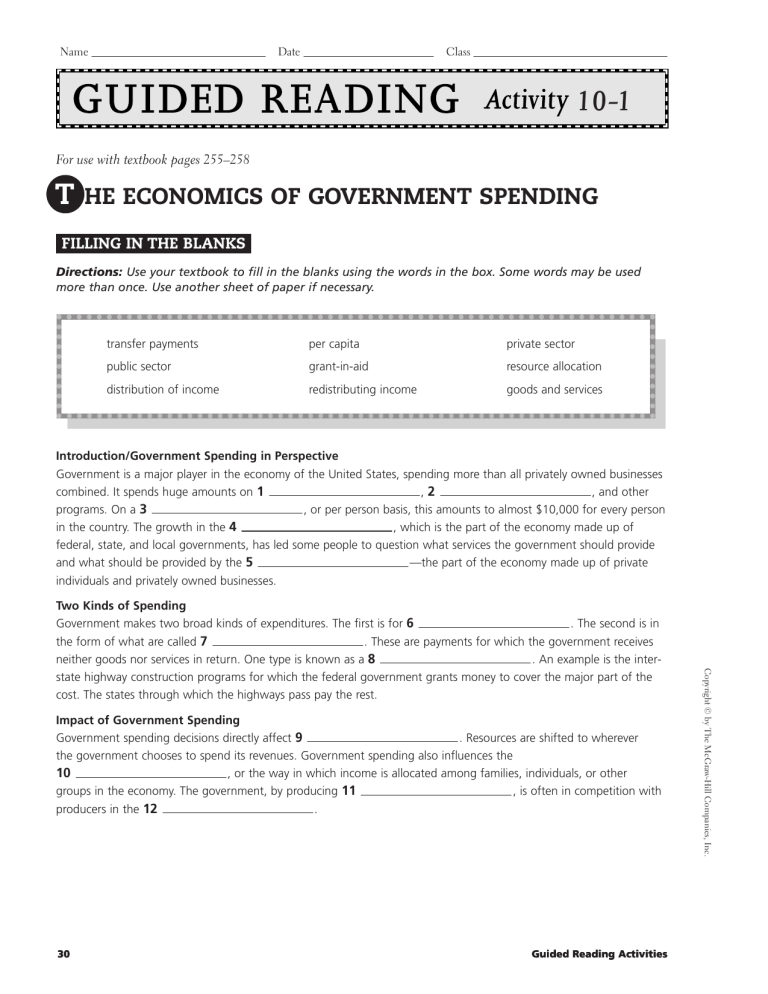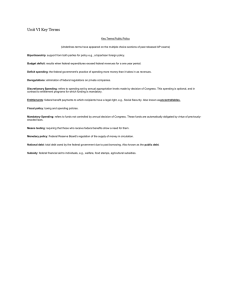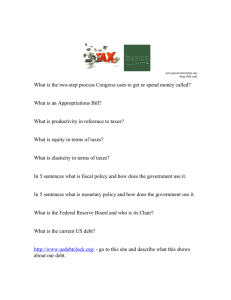
Name Date Class 10-1 For use with textbook pages 255–258 T HE ECONOMICS OF GOVERNMENT SPENDING FILLING IN THE BLANKS Directions: Use your textbook to fill in the blanks using the words in the box. Some words may be used more than once. Use another sheet of paper if necessary. transfer payments per capita private sector public sector grant-in-aid resource allocation distribution of income redistributing income goods and services Introduction/Government Spending in Perspective Government is a major player in the economy of the United States, spending more than all privately owned businesses combined. It spends huge amounts on 1 ,2 , and other , or per person basis, this amounts to almost $10,000 for every person programs. On a 3 , which is the part of the economy made up of in the country. The growth in the 4 federal, state, and local governments, has led some people to question what services the government should provide —the part of the economy made up of private and what should be provided by the 5 individuals and privately owned businesses. Impact of Government Spending . Resources are shifted to wherever Government spending decisions directly affect 9 the government chooses to spend its revenues. Government spending also influences the 10 , or the way in which income is allocated among families, individuals, or other , is often in competition with groups in the economy. The government, by producing 11 . producers in the 12 30 Guided Reading Activities Copyright © by The McGraw-Hill Companies, Inc. Two Kinds of Spending . The second is in Government makes two broad kinds of expenditures. The first is for 6 . These are payments for which the government receives the form of what are called 7 . An example is the interneither goods nor services in return. One type is known as a 8 state highway construction programs for which the federal government grants money to cover the major part of the cost. The states through which the highways pass pay the rest. Name Date Class 10-2 For use with textbook pages 260–265 F EDERAL GOVERNMENT EXPENDITURES RECALLING THE FACTS Directions: Use the information in your textbook to answer the questions. Use another sheet of paper if necessary. 1. What is the difference between mandatory spending and discretionary spending in the federal budget? 2. What is the difference between a fiscal year and the calendar year? 3. What branch of the government is responsible for developing the budget? 4. What is a federal budget surplus? 5. What is a federal budget deficit? Copyright © by The McGraw-Hill Companies, Inc. 6. What is an appropriations bill? 7. What is the Congressional Budget Office (CBO) and what is its role? 8. What are the 12 categories of expenditures in the federal budget? Guided Reading Activities 31 Name Date Class 10-3 For use with textbook pages 267–270 S TATE AND LOCAL GOVERNMENT EXPENDITURES FILLING IN THE BLANKS Directions: Use your textbook to fill in the blanks using the words in the box. Some words may be used more than once. Use another sheet of paper if necessary. elementary and secondary education interest on debt insurance trust funds balanced budget amendment bonds public utilities intergovernmental expenditures public welfare police protection higher education Introduction/Approving Spending Like the federal government, state and local levels of governments also have to go through a budget process. Some states have enacted a 1 , which is a constitutional amendment that requires that annual spending not exceed revenues. Under these conditions, states must cut spending when revenues drop. Local Government Expenditures . Spending on More than one-third of local government spending is on 8 9 , such as water and sanitation, amounts to the second most important expenditure. is higher than it is on the state level. As with the federal and Local spending on 10 state governments, local governments also borrow money for large capital expenditures, so they must budget for 11 . However, local governments spend much less than states on 12 . 32 Guided Reading Activities Copyright © by The McGraw-Hill Companies, Inc. State Government Expenditures . There are seven major categories of state government expenditures. The largest is 2 These are the funds that the state distributes to towns and cities. The second-largest category of expenditures is 3 . These payments take the form of cash assistance and payments for medical care. is invested until such time as people retire, become unemployed, or are Money in 4 , a traditional responsibility of state injured on the job. Another large category is 5 governments with their networks of state colleges and universities. States borrow money, usually by issuing 6 . As a result, they must pay 7 . Name Date Class 10-4 For use with textbook pages 272–278 D EFICITS, SURPLUSES, AND THE NATIONAL DEBT OUTLINING Directions: Locate the following headings in your textbook. Then use the information under the headings to help you write each answer. Use another sheet of paper if necessary. I. From the Deficit to the Debt A. From the Deficit to the Debt—What is deficit spending? a. B. Deficits Add to the Debt—What is the only way the annual budget can lower the federal debt? a C. How Big Is the Debt?—Why do most economists tend to disregard trust fund balances? a. D. Public vs. Private Debt—How much of the public debt is owned by foreigners? a. II. Impact of the National Debt—What happens to the purchasing power of individuals as a consequence of the federal debt? III. Taming the Deficit Copyright © by The McGraw-Hill Companies, Inc. A. Gramm-Rudman-Hollings—Why did GRH fail? a. B. Budget Enforcement Act of 1990—What is the BEA’s main feature? a. C. Omnibus Budget Reconciliation Act of 1993—What feature of this act helped account for the 1998 budget surplus? D. Balanced Budget Agreement of 1997—What is a spending cap? a. E. Success at Last—What is the connection between entitlements and mandatory spending in the federal budget? a. a. a. Guided Reading Activities 33




